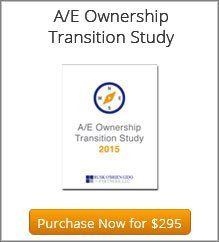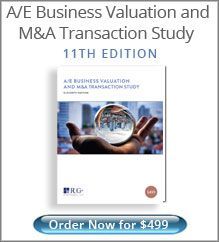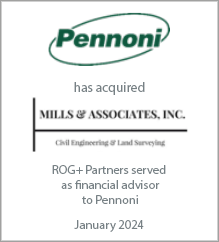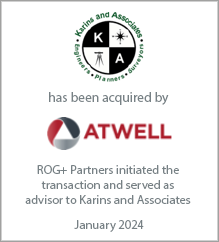Ian has spent the past twenty years working with hundreds of architecture, engineering and environmental consulting firms large and small throughout the U.S. and abroad with a focus on ownership planning, business valuation, ESOP advisory services, mergers & acquisitions, and strategic planning. Ian is a professionally trained and accredited business appraiser and holds the Accredited Senior Appraiser (ASA) designation with the American Society of Appraisers and is a certified merger & acquisition advisor (CM&AA) with the Alliance of Merger & Acquisition Advisors.
When Valuation “Rules of Thumb” Break Down
When Valuation “Rules of Thumb” Break Down
January 5, 2011
Human beings have a natural tendency to seek order and simplicity in an increasingly chaotic and complex world. In fact, the tactic of ignoring certain complexities is what allows us to make the hundreds if not thousands of decisions we’re faced with in our day-to-day lives. For example, imagine how long it would take to do the grocery shopping if you stopped to carefully consider all the factors that contribute to the relative value of each purchase. You could spend hours trying to decide which brand of toilet paper to buy!
Clearly, simplifying such decisions by choosing which factors to consider and which to ignore is necessary lest we all end up frozen in our tracks in the grocery aisle. This applies to business decisions as well, which brings me to the subject of this article—valuation “rules of thumb.”
Estimating the value of a privately held business is a complex discipline. A business appraiser must consider many factors such as the firm’s future earnings potential, its growth rate, the strength of its balance sheet, the capabilities and depth of its management team, the competitive environment it operates in, the outlook for the markets it serves, and more. The appraiser must also research comparable transactions in the public and private realm, determine appropriate rates of return, and ultimately apply all this empirical data to the subject company.
Given all this complexity, it’s easy to see why a business owner looking to understand the value of their firm would turn to simple “rules of thumb.” Such “rules of thumb” are ostensibly based on empirical data, but they have an insidious tendency to become self-fulfilling prophecies. For example, a common valuation rule of thumb in the A/E industry is that a firm’s fair market value should be approximately 1.5 times its book value. As more firms subscribe to this assumption and trade their stock based on this “rule of thumb” they create more data points to validate it. Along the way, nobody stops to ask “why 1.5 times book value?”
Clearly, simplifying such decisions by choosing which factors to consider and which to ignore is necessary lest we all end up frozen in our tracks in the grocery aisle. This applies to business decisions as well, which brings me to the subject of this article—valuation “rules of thumb.”
Estimating the value of a privately held business is a complex discipline. A business appraiser must consider many factors such as the firm’s future earnings potential, its growth rate, the strength of its balance sheet, the capabilities and depth of its management team, the competitive environment it operates in, the outlook for the markets it serves, and more. The appraiser must also research comparable transactions in the public and private realm, determine appropriate rates of return, and ultimately apply all this empirical data to the subject company.
Given all this complexity, it’s easy to see why a business owner looking to understand the value of their firm would turn to simple “rules of thumb.” Such “rules of thumb” are ostensibly based on empirical data, but they have an insidious tendency to become self-fulfilling prophecies. For example, a common valuation rule of thumb in the A/E industry is that a firm’s fair market value should be approximately 1.5 times its book value. As more firms subscribe to this assumption and trade their stock based on this “rule of thumb” they create more data points to validate it. Along the way, nobody stops to ask “why 1.5 times book value?”
I’ve had the pleasure of working with hundreds of A/E firms on valuation and ownership planning projects and have seen many that use simple “rules of thumb” methodology to set their stock value. And while I have no issue with well-conceived and constructed valuation formulas, I cringe when I see firms blindly applying “rules of thumb.” Unlike buying a roll of toilet paper, establishing the share price of your company’s stock is one decision that SHOULD involve careful consideration of the many complexities.
Here’s where rules of thumb tend to break down:
1. When they are based on factors that have little correlation to fair market value. Book value rules of thumb are a prime example of this. A/E firms generate revenue and earnings by delivering professional services. They generally have insignificant tangible assets compared to other industries. In fact, the largest single asset on most A/E firms’ balance sheet is accounts receivable. Furthermore, the best performing firms will collect their receivables quickly, and therefore might actually have fewer assets and a lower book value than a poorly performing firm.
2. When they’ve lost relevance due to fundamental changes in the market. The value of a business enterprise should be equal to the present value of the future cash flow it is able to generate. The reliability of common valuation “rules of thumb” is dependent upon built-in assumptions about profitability, growth rates, working capital turnover, fixed asset investment and more. They also assume that external forces such as the tax code, interest rates, inflation rates and capital markets remain unchanged. A six or seven times EBITDA (earnings before interest, taxes, depreciation and amortization) multiple might have been appropriate when firms could be confident in sustaining certain levels of profitability and growth. But what happens when economic conditions create significant earnings volatility and revenue is flat or declining? Should the same rule of thumb apply? Of course not.
3. When they are applied to a company with atypical performance. Another
valuation rule of thumb in the A/E industry is 40% of net service revenue. But again, this assumes a level of profitability and growth typical for the industry. Two firms with the same revenue levels but wildly different profitability should not be valued at the same level. Rules of thumb always work best when applied to firms that are “typical” for the industry. When a firm is atypical, for example a firm with extraordinarily high profit margins, industry rules of thumb will produce unreliable results.
4. When they are too simplistic. Let’s pick on those book value rules of thumb again. “Book value” refers to a firm’s assets minus its liabilities on its balance sheet. Applying this multiple to your book value with the expectation of getting an accurate indication of fair market value would assume that your firm measures its book value the same way as the firms from which this multiple was derived. But firms differ widely in their accounting methods. For one thing, pass-through tax entities like S-corporations and LLCs as well as accrual basis tax payers may not have deferred income tax liabilities on their books, while C-corporations that pay taxes on a cash-basis may have millions of dollars of deferred income tax liabilities. Larger, more sophisticated firms will book work-in-process (WIP) as an asset on their balance sheet, while smaller firms may not. I could go on and on, but suffice it to say that “book value” may have different meanings for different firms.
5. When the historical performance they’re applied to differs significantly from future performance. This is a particularly acute problem today. Many firms have downsized considerably over the past two years. Applying a rule of thumb to a measure of historical performance in such cases effectively ignores the current reality. In such cases, any backward looking formula could be problematic. What might be required is a professional appraisal from an independent third party.
6. When they are not based on observed arms-length transactions. If I were to go around to all my neighbors and ask them what they thought their homes were worth, then create a rule of thumb based on that (e.g., all homes in this neighborhood are worth $250/square foot) would that be a reliable indicator of value? Would you buy a home based on that rule of thumb? I hope not. But that’s exactly how many rules of thumb are developed. On the other hand, if I were to base my rule of thumb on actual sales of homes, it would be a different matter entirely.
The bottom line is that valuation “rules of thumb” have their place. If you’re simply curious about the value range your firm might fall in, or are “gut checking” a third-party valuation analysis, that’s probably fine. Just be aware of the limitations and potential pitfalls, and if there’s real money at stake, get a professional valuation from a qualified and independent business appraiser.
Latest Perspective
Perfecting the A/E Exit Strategy – Five Key Factors
An enormous A/E generation that kicked off their careers in the 1980s and subsequently started firms or became owners in the 1990s ...
© 2024
Rusk O'Brien Gido + Partners, LLC
Financial Experts for Architects, Engineers, and Environmental Consulting Firms









